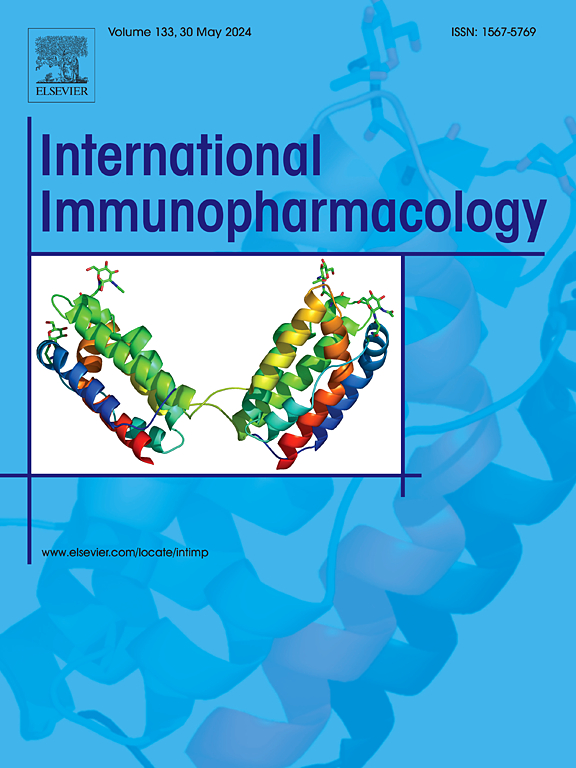血浆和尿液代谢组学用于鉴定硫芥菜诱导肺损伤的诊断性生物标志物
IF 4.7
2区 医学
Q2 IMMUNOLOGY
引用次数: 0
摘要
硫芥子气(SM)是一种高度致命的化学战剂,暴露在其下的个体会引起严重的健康并发症。了解SM暴露引起的代谢变化对于了解其潜在机制和制定有效的诊断和治疗干预措施至关重要。方法本研究采用非靶向方法,利用质子核磁共振(H-NMR)对诊断为芥菜肺疾病(MLD)的患者进行代谢组学分析。对54例患者的血浆和尿液样本进行代谢物测量,其中20例为轻度MLD, 20例为中度MLD, 14例为健康个体。应用多变量和单变量分析来鉴定不同组之间的代谢物,并进行富集分析以揭示所涉及的潜在生化途径。结果通过多变量分析,获得的代谢谱有可能区分中度血浆和健康血浆,但不能区分轻度血浆。血浆中16种代谢物被认为在中度组和对照组之间存在显著差异(VIP >;1和p <;0.05),这些代谢物参与脂肪酸和氨基酸的代谢。利用所有16种代谢物作为组合面板,我们能够区分中度组和对照组,实现曲线下面积(AUC)为0.854。此外,在轻度组与对照组、中度组与对照组之间分别检测到6和8种尿代谢物。14种代谢物表现出显著的折叠变化(FC) (FC <;0.66或FC >;1.5;p & lt;0.05)。这些代谢物参与氨基酸和烟酸代谢。我们的研究为MLD相关的代谢变化提供了新的见解,并强调了参与疾病进展的潜在途径。这些发现对MLD的有针对性的诊断和治疗策略的发展具有启示意义。本文章由计算机程序翻译,如有差异,请以英文原文为准。
Plasma and urine metabolomics for the identification of diagnostic biomarkers for sulfur mustard-induced lung injury
Background
Sulfur mustard (SM) is a highly lethal chemical warfare agent that induces severe health complications in exposed individuals. Gaining insights into the metabolic changes caused by SM exposure is essential for understanding its underlying mechanisms and developing effective diagnostic and therapeutic interventions.
Methods
In this investigation, we utilized proton nuclear magnetic resonance (H-NMR) spectroscopy to conduct metabolomic analysis in patients diagnosed with mustard lung disease (MLD) using a non-targeted approach. Metabolite measurements were conducted on plasma and urine samples collected from a total of 54 individuals, including 20 individuals with mild MLD, 20 individuals with moderate MLD, and 14 healthy individuals. Multivariate and univariate analyses were applied to identify metabolites that distinguish between the different groups, and enrichment analysis was performed to unveil the underlying biochemical pathways involved.
Results
The obtained metabolic profile had the potential to differentiate moderate from healthy plasma, but not from mild patients using multivariate analysis. Sixteen metabolites from plasma were considered significantly different between the moderate and control groups (VIP > 1 and p < 0.05) that these metabolites involved in fatty acid and amino acid metabolism. Utilizing all 16 metabolites as a combined panel, we were able to distinguish between the moderate and control groups, achieving an area under the curve (AUC) of 0.854. Moreover, 6 and 8 urinary metabolites were detected between mild vs. control and moderate vs. control groups, respectively. Fourteen metabolites exhibited significant fold changes (FC) (FC < 0.66 or FC > 1.5; p < 0.05). These metabolites are involved in amino acid and nicotinate metabolism.
Conclusion
Our study provides novel insights into the metabolic changes associated with MLD and highlights potential pathways involved in the disease progression. These findings have implications for the development of targeted diagnostic and therapeutic strategies for MLD.
求助全文
通过发布文献求助,成功后即可免费获取论文全文。
去求助
来源期刊
CiteScore
8.40
自引率
3.60%
发文量
935
审稿时长
53 days
期刊介绍:
International Immunopharmacology is the primary vehicle for the publication of original research papers pertinent to the overlapping areas of immunology, pharmacology, cytokine biology, immunotherapy, immunopathology and immunotoxicology. Review articles that encompass these subjects are also welcome.
The subject material appropriate for submission includes:
• Clinical studies employing immunotherapy of any type including the use of: bacterial and chemical agents; thymic hormones, interferon, lymphokines, etc., in transplantation and diseases such as cancer, immunodeficiency, chronic infection and allergic, inflammatory or autoimmune disorders.
• Studies on the mechanisms of action of these agents for specific parameters of immune competence as well as the overall clinical state.
• Pre-clinical animal studies and in vitro studies on mechanisms of action with immunopotentiators, immunomodulators, immunoadjuvants and other pharmacological agents active on cells participating in immune or allergic responses.
• Pharmacological compounds, microbial products and toxicological agents that affect the lymphoid system, and their mechanisms of action.
• Agents that activate genes or modify transcription and translation within the immune response.
• Substances activated, generated, or released through immunologic or related pathways that are pharmacologically active.
• Production, function and regulation of cytokines and their receptors.
• Classical pharmacological studies on the effects of chemokines and bioactive factors released during immunological reactions.

 求助内容:
求助内容: 应助结果提醒方式:
应助结果提醒方式:


